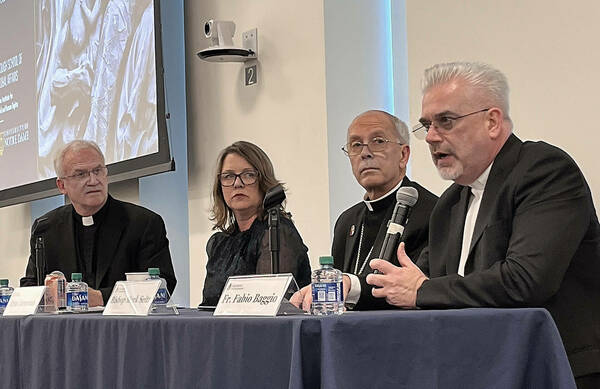
Prompted by increasing mass displacements and humanitarian crises around the globe, an emerging initiative on migration at the University of Notre Dame took a critical step forward on April 25. Eighteen scholars and practitioners from Notre Dame and across the U.S., along with representatives of the Catholic Church, met for a full day at the Keough School of Global Affairs to discuss how Notre Dame can best contribute its expertise and resources.
Housed in the Keough School’s Klau Institute for Civil and Human Rights, the new initiative will draw upon strengths already in place at Notre Dame while seeking to build new capabilities and explore promising avenues of research. In a public event held at the conclusion of the workshop, three of the participants shed light on the priorities that drive the migration effort. The conversation was led by Fr. Daniel Groody, vice president and associate provost for undergraduate education, an internationally recognized leader in the study of migration.
Fr. Fabio Baggio, co-under-secretary of the Migrants and Refugees Section of the Holy See’s Dicastery for Integral Human Development, began by grounding the discussion in values that are basic to Catholic Social Teaching. “Respect for human rights is something which is to be is applicable to every single human being, but particularly to those that are normally excluded because they are not a citizen,” Fr. Baggio said. “It is not true in all countries, but there are many countries claiming that there are different fundamental rights for citizens and for immigrants.”
Seeking to frame an alternate, extranational approach, Fr. Baggio drew attention to the most important causes of migration, particularly access to the conditions where people are allowed to fulfill themselves, their family, and their community. If there is no access to these fundamental rights, he said, people will travel elsewhere to find where it is allowed.
Addressing the hurdles such an approach is likely to face as it seeks to inform policy, Bishop Mark Seitz, chair of the US Conference of Catholic Bishops Committee on Migration, focused on the culture of fear that uses migrants as weapons to foster polarization. In contrast, he said, a culture of direct encounter with migrants dissolves false political and media images.
“We're living in a country right now where immigration is being used as a political bludgeon,” the bishop observed. “Politicians have found that if they speak about immigration as a threat, they can get a lot of political gain. They use words that engender fear, like 'invasion.' People have an image in their mind of what an invasion is. It's a threat to our sovereignty.”
“People think of a border as a place of confrontation, a place of separation. And we say, no.”
A focus on immigrants as individuals, according to Erin Corcoran, executive director of the Kroc Institute for International Peace Studies, located in the Keough School, is key to informing policy and policy makers. Recalling her work in the U.S. Senate, Corcoran said that “once someone encounters and gets to know a migrant, they change how they see that person and they change how they see the issue. Narrative was absolutely essential.”
“When I was working on comprehensive immigration in the U.S. Senate, many of the members who voted in support of immigration were moved by moral considerations,” she said. “They felt a higher calling in office, not just to serve their basic constituent desires, but that they had a responsibility as an elected official to be called to something higher. I think that's something that we should think about with our legislators.”
All three panelists emphasized the need to communicate the immediate stories of human lives across and between borders. For Bishop Seitz, the story becomes vivid each year, when his El Paso congregation holds mass on the U.S.-Mexico border.
“We send in a team, very often of immigrants, who build a platform [in the middle of the Rio Grande River] early in the morning and we celebrate mass on this platform. Bishops from Mexico come from their side. We come from our side. It's a very powerful experience of the unity that the Eucharist bespeaks lived out across our image of what a border ought to be,” he said.
“You know, people think of a border as a place of confrontation, a place of separation. And we say, no.”